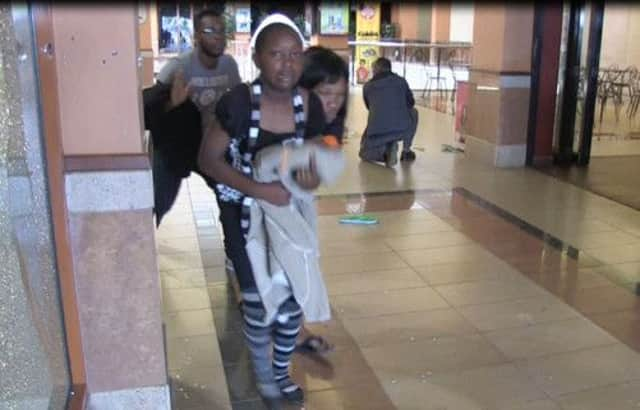Kenya terror attack survivors’ traumatic stories


The first grenades were thrown at the security officers guarding Westgate shopping mall. The gang opened fire indiscriminately, taxi drivers were gunned down as they waited for fares.
Inside, hundreds of shoppers were in the upmarket retail centre enjoying their weekend as the gunmen and women stormed in.
Advertisement
Hide AdAdvertisement
Hide AdIn the panic, some shoppers ran for their lives, others took cover behind counters as the attackers threw grenades and sprayed the crowds with machine gun fire.
The dead were left strewn around tables of unfinished meals. At one burger restaurant, a man and woman lay in a final embrace. Pop music was still playing on the sound systems.
Ben Mulwa was in his car with a friend at a security checkpoint when the first shots were fired.
“The gunfire was sustained, and I left the car and hid behind a flowerbed,” he said. “A security guard lay next to me and he was shot in the head and died immediately. A bullet fired at me missed by a whisker and I lay as if dead.”
About ten minutes later, he heard security officers calling for those who could exit the shopping centre safely to do so.
“That’s when I realised I had been shot in the leg,” Mr Mulwa said.
Rufus Gitao was inconsolable as he told of his three-hour ordeal trying to have his injured son rescued from the mall.
After learning that Westgate was under attack, Mr Gitao said he phoned his son, a shopworker. “He told me: ‘Dad, I’ve been shot in the neck and hand but please don’t call me again because they are saying anybody who is Christian will be executed,” recounted Mr Gitao.
Advertisement
Hide AdAdvertisement
Hide AdHe raced to the shopping centre but could not get past a security cordon.
After three hours, security officers managed to pull out Mr Gitao’s 27-year-old son, alive but unconscious from blood loss.
Another woman who was too shaken to give her name said she was rescued unhurt at 4:30pm on Saturday – four hours after the attack began.
A worker on the ground floor of the shopping centre, she said she watched in horror as the attack unfolded.
“A Toyota was driven to the entrance where the security guards were standing. They then threw grenades at the guards, killing some of them.
“Another group of attackers joined those from the vehicle as they entered the building, shooting indiscriminately,” she said. The woman said she hid under a seat, together with four of her colleagues, to save her life.
“They [attackers] were speaking in Somali language; I haven’t seen such terror in my life,” she said.
During a lull in the firing the attackers called out in Swahili, a language widely spoken in Kenya and the rest of east Africa, for Muslims to identify themselves and leave.
Advertisement
Hide AdAdvertisement
Hide AdOne man told how he covered up the Christian name on his ID with his thumb as he was approached one of the attackers who wanted to see the identity card. “They told me to go. Then an Indian man came forward and they said, “What is the name of (the Prophet) Muhammad’s mother?’ When he couldn’t answer they just shot him.”
A taxi driver identified as John said he was arriving from the city centre when the gunmen attacked. He said his friend David Asala was by his cab when the attackers struck.
“I just saw men whose faces were covered shoot at the watchmen at the gate. We [taxi drivers] parked outside next to the gate and they shot at us without a word,” he recounted from his hospital bed. “People coming from inside were ordered to speak Somali and those who failed were shot.”
Mr Asala, who had a bullet lodged in his left thigh, said he was lucky to be alive. “I fell down and maybe they thought I was dead. Most of my colleagues were shot in the stomach and some in the head,” he added.
Some witnesses said the female gang leader was white. This assertion is lent credence by the fact that Al-Shabaab, which has claimed responsibility for the attack, does not recognise female leaders, but would use help from those who knew areas frequented by Westerners.
Most of the victims are reported to be wealthy Kenyans and foreigners who frequent the shopping centre.
Profile of terror group
Al-Shabaab, which means ‘The Youth’ in Arabic, emerged as a radical force in Somalia in 2006, fighting Ethiopian forces which had entered the country to support the weak interim government.
Led by Ahmed Abdi Godane, it has links to al-Qaeda and is known to count foreign jihadists among its 7,000 to 9,000 members.
Advertisement
Hide AdAdvertisement
Hide AdWhile it has lost control of Somalia’s cities, it has imposed strict Sharia law in rural areas, including stoning to death women accused of adultery and amputating the hands of thieves.
The group was responsible for a double suicide bombing in Uganda, which killed 76 people watching the 2010 football World Cup final on television.